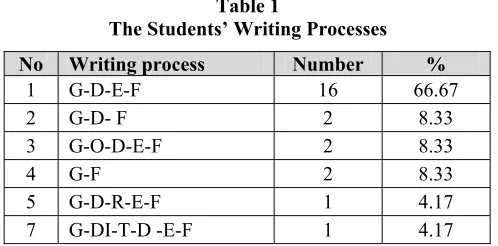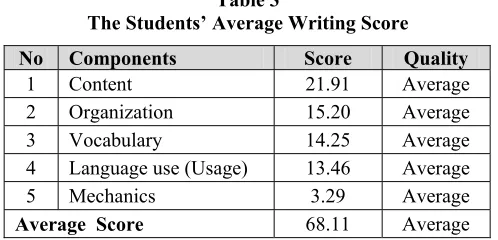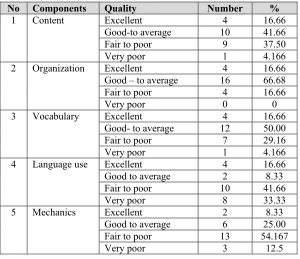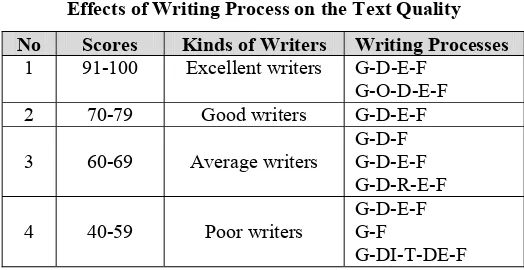Effects of Process Oriented Approach to Teaching Writing to English Department Students
Agustinus Ngadiman
Abstract. This study investigated the effects of process oriented approach to teaching writing to the English Department students. It was a one-shot case study. The subjects were English Department students of Widya Mandala Catholic University Surabaya taking the Writing Course I for 14 meetings focusing on the recount, biography and narrative genres in the academic year 2006-2007. The study revealed that the writing processes taken by the students varied according to the types of writers (the good and the poor). The study also proved that to some extent writing processes the students took had significant effects on the English texts they composed
Key words: process oriented approach, teaching writing, quality effects.
Introduction
This study aimed at determining the effects of process oriented approach to teaching writing to English department students. The process oriented approach refers to a teaching that focuses on the process as a writer engages in when constructing meaning and concludes with editing as a final stage in text creation, rather than an initial one as in a product oriented one. This approach may include identified stages of the writing process such as (1) prewriting, (2) composing/drafting, (3) revising, and (4) editing (Tribble, 1996). Once the rough draft has been created, it is polished into subsequent drafts with teacher’s assistance and student conferencing. Final editing and publication can follow if the author chooses to publish their writing (Murray, 1972). These stages are, however, recursive, or nonlinear, and they can interact with each other throughout the writing process. For example, many writers return to prewriting activities during some stage of the revision process to develop a new idea or refine a viewpoint. This approach emphasizes revision, and feedback from others. Students may produce many drafts with much crossing out of sentences and moving around of paragraphs. The correction of spelling and punctuation is not of central importance at the early stages.
Since many students writers do not possess the strategies to recall, trigger, and activate these stored experiences while writing, the role of the teacher in strategy training is paramount. The result will be improved student writing because the connection with the topic and processes gives students something interesting to write about and the tools to do it.
The process oriented approach to teaching writing in the classroom is an idea that began three decades ago (in the mid-1970) as the result of extensive research on literacy acquisition for majority language learners (Montague, 2007) and has began to replace the product approach. Since that initial research, this process oriented instruction has been used in many classrooms across the country with different types of learners, implemented by different types of interpretations and teaching styles (Reyes, 1991).
Though, the process approach has been criticized because it views the process as the same for all writers, regardless of what is being written and who is doing the writing and because of insufficient importance to the purpose and social context of the piece of writing, it is widely accepted and utilized because it allows students to understand the steps involved in writing, and recognizes that what learners bring to the writing classroom contributes to the development of the writing skill (Bagger and White, 2000).
According to the cognitive theory, communicating in writing is an active process of skill development and gradual elimination of errors as the learner internalizes the language. Writing in a second/foreign language can be divided into three stages: construction, transformation and execution.
In the construction stage, the writer plans what he/she is going to write by brainstorming, using mind-map or outline. In structuring information, the writer uses types of various kinds of knowledge, including discourse knowledge, understanding of audience, and sociolinguistic rules. Organization at both sentence and the text level is also important in effective communication of meaning, and ultimately for the quality of the written product. The first two stages are described as “setting goals and searching memory for information, then using production systems to generate language and phrases or constituents (O’Malley & Chamot, 1990: 42)
analyze and evaluate the feedback they receive on their writing. The execution corresponds to the physical process of producing the text.
Previous studies on second language writing process show that writing strategies have significant effects on writing products (Kroll. 1990: 39). Chelala (1981) in conducting a research on the first and second language writing process of effective behaviors and ineffective behavior identified that ineffective writers used the first language for prewriting and switching back and forth between the first and second language. A similar study was done by Jones (1982). He investigated the written products and writing process of ‘poor’ and ‘good’ L2 writers. The subjects ‘composed aloud” as they produced a self-generated narrative and revised a paragraph of kernel sentences. He analyzed the composing strategies by noting two composing Behaviors writing or generating text and reading the texts already generated. His findings indicated that writing strategies affected writers’ rhetorical structures. According to Jones, the poor writers were bound to the text at the expense of ideas, whereas the good writers allowed her ideas to generate the text.
A similar study was done by Zamel (1983). The subjects were her own university-level students. In this study she found that the skilled writers revised more often and spent more time on their essays than the unskilled writers. In general the skilled writers concerned themselves with ideas first, revised at the discourse level exhibited recursive ness in the writing process and saved editing until the end of the process. The unskilled writers revised less and spent less time writing than skilled. They focused on small bits of the essay and edited from the beginning to the end of the process. .
A recent study on L2 writing process was done by Silva (1993). In his research on how L2 learners revise their work he observed that learners revise at a superficial level. They re-read and reflect less on their written text, revise less, and when they do. The revision is primarily focused ungrammatical correction. On the other hand L1 writing ability may also transfer to L2. As a result, students who are skilled writers in their native language and have surpassed a certain L2 proficiency level can adequately transfer those skills. Of course those who have difficulty writing in their native language may not have a repertoire of strategies to help them in their L2 writing development (Sasaki & Hirose, 1996)
was a manifestation of writing process that cannot be acquired over a short period of time.
Methodology
It was a one-shot case study investigating the effects of process-oriented approach in teaching English composition on the students’ writing process and products. The subjects were S-1 students of the English Department students of Widya Mandala Surabaya taking the writing I Course focusing on the three genres of English Composition, narratives, recount and (auto-) biography. The process-oriented approach was applied in teaching the Writing I Course to those students for 14 meetings.
The composing process data were the students’ writing activities in producing English composition in the end-semester test which were taken through direct observation, interview and retrospective accounts of composing drawn from the papers submitted by the students including the outlines and the writing drafts. The product-oriented data consist of multiple drafts, and holistic assessments of the students’ composing skill.
To know the quality of the essays produced by the subjects under study, each essay was analyzed and rated using an ESL profile (appendix 1), in terms of its content, organization, vocabulary, language use (usage), and mechanics. .
Results
The Writing Process Patterns
The study identified that each student took different phases of writing process. There were six varieties of writing processes pattern found in the study: (1) Generating idea - Drafting - Editing - Finalizing (G-D-E-F, (2) Generating idea - Drafting - Finalizing (G-D-F), (3) Generating idea - Outlining - Drafting - Editing -Finalizing (G-O-D-E-F), (4) Generating idea - Finalizing (G-F), and (5) Generating idea – Drafting –Revising – Editing - Finalizing (G-D-R-E-F), (6) Generating idea - Drafting in Indonesian - Translating - Drafting in English - Editing - Finalizing (G-DI-T-D-E-F). As presented in table 1, most students (66%) employed the G-D-E-F steps in their writing processes. The first step taken by these students was generating ideas. After finding out the ideas to be put in the paper, they wrote the writing draft. The draft was then edited by checking and correcting the mistakes found in the draft, such as grammatical and spelling mistakes. The last step done was finalizing. The finalized text was then submitted to the Procter.
Two students writing an outlines before developing the ideas they had generated. Based on the outline they made, they developed the ideas in the writing draft. Their drafts were then proofread and edited by checking and improving the mistakes in the draft, such as mistakes in grammar, spelling and mechanics Thus they took the Generating ideas, Outlining, Drafting, Editing-and Finalizing steps or the G-O-D-E-F process.
Two students in the study took only two steps generating ideas then finalizing. These students directly put the ideas they had in mind on the paper, finalizing it and submitted the composition to the Procter.
The fifth writing process pattern found in the study was the G-D-R-E-F, generating ideas, drafting, revising, editing and finalizing. There was only one student employed this writing process. Revising the writing draft was an activity which was not done by other students. Irrelevant ideas found in the draft previously made were changed to make the composition coherent. Due to the longer steps taken in the writing process, this student needed longer time than other students in finishing the composition.
The last writing process pattern found was the G-DI-T-D-E-F. This writing process was taken by only one student. Based on the ideas she had generated, the students wrote a writing draft in Indonesia. Thus the pre-writing was done in Indonesian. The result of this pre-writing was then translated into English. The translated draft was then proofread and revised; the mistakes, such as mechanic, grammatical, spelling mistakes were corrected improved. This student taking these steps had longer time than other students in finalizing the composition.
Table 1
The Students’ Writing Processes
No Writing process Number %
1 G-D-E-F 16 66.67
2 G-D- F 2 8.33
3 G-O-D-E-F 2 8.33
4 G-F 2 8.33
5 G-D-R-E-F 1 4.17
7 G-DI-T-D -E-F 1 4.17
Another finding is that the writing processes taken by the good writers and the poor one differed in some respects (Table 2). They were different at least in three ways:
less proficient writers preferred to begin to write “just by beginning.” Good writers tended to have flexible plans and did not feel compelled to stick to their original ideas if they saw a reason for changing the course of their thinking while in the process of composing.
2. Reasoning. Good writers stopped rather frequently to reread what they had already written before continuing to compose. Good writers tended to pause nearly twice as often during writing and to rescan their work three times often as remedial students did. They had a sense of the whole composition. By rereading, planning what to write next, and then rescanning to see if the plan fitted, they invariably ended up with better products.
3. Revising and editing. Good writers tended to revise more than poor writers did and they revised somewhat differently. Whereas poor writers tended to pay attention more often to surface form in their revision, good writers made more changes in content and tried to find the line of their argument in the finished draft in order to see if revisions were necessary. However, it was found that most of them could not differentiate between revising and editing; they did not know well what to do in the revision and in the editing phases. What they did in this phase was just correcting the grammatical mistakes or vocabulary, rather than the content and organization.
Table 2
The Writing Processes Taken by the Good and the Poor Writers
No Scores Predicate Number % Writing Processes
1 91-100 Excellent
The Effects Writing Process on the Quality of the Essay Produced
Table 3
The Students’ Average Writing Score
No Components Score Quality
1 Content 21.91 Average
2 Organization 15.20 Average
3 Vocabulary 14.25 Average
4 Language use (Usage) 13.46 Average
5 Mechanics 3.29 Average
Average Score 68.11 Average
In terms of the content or the subject matter, on the average they had enough materials to be developed but lacked detail (Table 3). Table 4 shows that there were only 4 students or 16.67% of the subjects who were knowledgeable and gained relevant substance developed. Ten students or 41.66% of the subjects had adequate range but limited details developed. Nine students or 37.50% of the subjects had limited knowledge of subject matter; most of the substances developed were inadequate or irrelevant. The study also found that there was only one student poor in the content. This student did not show knowledgeable of subject.
In terms of the organization, on the average, the students acquired average score, 15.20 (Table 3). As presented in table 4 only four students or 16.66 of the students were excellent in organizing ideas. However, the organization of the essay written by 16 students or 66.68 % of the subjects was somewhat choppy and had incomplete sequencing. In addition, the ideas were loosely organized with limited supports (details)
The vocabulary employed in the essay is presented in tables 3 and 4. Table 4 shows that the average score gained for the vocabulary employed was 14.25. It is stated that 12 students or 50% of the subjects were good to average in employing the vocabulary in the essay. The vocabulary mastery was adequate. However, occasional errors of words or idiom forms were found. As shown in table 4 there was only one student who had little knowledge of English vocabulary.
The students’ score on language use (usage) in the composition, as shown in table 4, is rather poor (13.46). Ten students or 41.66 % of the subjects gained average score (Table 4).The major problems they encountered were in construction compound and complex sentences. They also had problems in subject-verb and number-noun agreements, tenses, articles, pronouns, and preposition. As shown in table 4, 8 students or 33.33% of the subjects were very poor in the language use. They had little mastery of sentence construction rules. Sometimes the sentences they constructed do not communicate at all, such as:
• The Campus of Kalijudan of Widya Mandala Surabaya are the place to study of many people from around Indonesia.
• When we felt tired together came back for our house
Those sentences are ungrammatical and even do not communicate at all. They just group of word do not make any sense/meaningless.
The mechanics encountered in the students’ composition were rather good, the average gained score was 3.29 (Table 4). However, as shown in table 4, 13 students or 54.167% of the subjects were poor in the mechanics. They made frequent errors in spelling, punctuation, capitalization and paragraphing. There were 3 or 12.50 % of the students whose mechanics were very poor. They had no mastery of conventions. Their compositions were dominated by errors of spelling, punctuation, capitalization and paragraphing. The following examples consist of capitalization and punctuation errors:
* one day, they worked in the same group to make - a marvelous robot.
* but I always tried made her believe with me
every Sunday Morning I taked her for played together in the first time she felt afraid
here, I give her unforgettable moment. Which made her happy and pleasure?
Table 4
The Scores on Each Composition Component
No Components Quality Number %
Excellent 4 16.66
Good-to average 10 41.66
Fair to poor 9 37.50
1 Content
Very poor 1 4.166
Excellent 4 16.66
Good – to average 16 66.68
Fair to poor 4 16.66
2 Organization
Very poor 0 0
Excellent 4 16.66
Good- to average 12 50.00
Fair to poor 7 29.16
3 Vocabulary
Very poor 1 4.166
Excellent 4 16.66
Good to average 2 8.33
Fair to poor 10 41.66
4 Language use
Very poor 8 33.33
Excellent 2 8.33
Good to average 6 25.00
Fair to poor 13 54.167
5 Mechanics
Similar to the previous studies, this study proved that writing process approach to some extent had different effects on the compositions of different types of writers, the effective (good) and the ineffective (poor) writers. As presented in table 5 below, good writers tended to take longer phases in producing English composition than the poor. The rough draft was revised and re-written carefully. The result was that the composition was better with fewer errors than those written by the ineffective (poor) writers. The poor (ineffective) writers did not revise their compositions. They just directly put their ideas on paper then finished. The result was that the compositions were full of mistakes (errors) in grammar, spelling and mechanics.
As presented in table 5, the student who wrote the draft in Indonesian in the prewriting process produced poor composition. The composition was full of interlingual errors, besides other kinds of errors, due to negative transfer, such as grammatical, lexical and rhetorical errors. Many sentences constructed are found meaningless; they do not communicate at all, as in the following example.
When the times only left two month, one day in the front of the class the gaze of Yohanes maked Hadi think, “I must work together with Yohanes, because the times is very thin right now, if not how could I finish the robot”. When Hadi wanted to speak to Yohanes, Yohanes said “I know I’m wrong because I’m too selfish. Would you forgive me Hadi?” Hadi imply “Sure. So let go to the lab to finish the program” and Yohanes said “Ok”. So from that two month they finish the program and construct the body of the robot.
Table 5
Effects of Writing Process on the Text Quality
No Scores Kinds of Writers Writing Processes
1 91-100 Excellent writers G-D-E-F G-O-D-E-F
2 70-79 Good writers G-D-E-F
3 60-69 Average writers
G-D-F G-D-E-F G-D-R-E-F
4 40-59 Poor writers
G-D-E-F G-F
G-DI-T-DE-F
Discussion
produced. The average gained score was just on the average, either on the content, organization, vocabulary, language use or mechanics. This does not mean that the process oriented approach is not effective for teaching writing to English Department students. This ineffectiveness may be due to the following reasons. First, the subjects were the students taking the Writing I Course who were still struggling for their English. Their schemata about what to write and how to write in English were still weak. Second, they might not have inappropriate concept about what writing is. They, especially the poor writers, might think that writing was merely constructing grammatical sentences rather than producing meaningful discourse.
The previous studies reported that good writers took different phases in the writing process. The focus they had in phase was also different. The skilled writers concerned themselves with ideas while unskilled writers concerned more on the superficial level, such as ungrammatical correction than on the idea. The present study did support those previous studies. The phases the good writers took and what they did in each phase were different from the poor writers. The good writers focused more on the ideas than on the superficial level while the poor writers focused more on the grammatical correctness than on the ideas. The good writers tended to take longer time in completing the composition than the poor ones.
Conclusion
Based on the discussion above some conclusions can be drawn. First, the writing process taken by the students varies between the good writers and poor writers. The good writers (students) took longer phases in their writing process than the poor students, though the focus was almost the same, on the grammar rather than on the content. The poor students pay less attention on the content and mechanics than the good writers (students). Second, the process oriented approach applied in this study has not yet significantly improved the quality of the students’ compositions. Perhaps they have not yet known the appropriate stages of writing process. It seems that, for them writing is just producing correct grammatical sentences rather than meaningful discourse, a threads of sentences which are coherent and cohesive.
References
Badger, R.G. and C. White. 2000. A Process Approach to Teaching Writing. ELT Journal 54 (2):153-60
Chelala. S. 1981. The Composing Process of Two Spanish-Speakers and the Coherence of Their Texts: A case Study. Unpublished Doctoral Dissertation, New York University
Graves R. (Ed) Rhetoric and Composition. A Source Book for Teachers and Writers. Upper Montclair, NJ: Boynton/Cook
Harfiel, V. Faye, Jane B. Hugey, Deanna R. Wormuth, Holly L. Jacobs. 1981. English Composition Program. Learning ESL Composition. Massachusetts: Newbury House Publishers.
Hillocks, George. 1986. Research on Written Composition. New Directions for Teaching. Urbana, Illinois: The National Conference on Research in English.
Jones, S. 1982. Attention to Rhetorical Information While Composing in Second Language. In Campbell, V. Falsner, T. Hudson, and J. Lubin (Eds) Preceeding of the Loss Angels Second Language Research Forum, vol. 2, 130-134. Angeles: Department of English, ESL Section, UCLA
Kroll, Barbara (Ed). 1991. Second Language Writing. Research Insights for the Classroom. Cambridge: Cambridge University Press.
Meyles, Johanne. 2002. Second Language Writing and Research: The Writing Process and Error Analysis in Student Texts. Teaching English as a Second or Foreign Language. Vol.6. No. 2
Montague, Nicole. 1995. The Process Oriented Approach to Teaching Writing to Second Language Learners. New York State Association for Bilingual Education Journal (10):13-24. http://www.ncela.gwu.edu/pubs/mysahe/vol10/nysabe103.htm. 3/30/2007
Murray, D. 1972. Teach Writing as a Process not Product. In Graves R (ed) Rhetoric and Composition. A Source Book for Teachers and Writers (89-92). Upper Montclair, NJ: Boynton/Cook
Moody, Patricia A. 1981. Writing Today a Rhetoric and Handbook. New Jersey: Prentice-Hall.
Nagin, Carl. 2003. Because Writing Matters. Improving Student Writing in our School. National Writing Project. San Francisco: Jossey-Bass
Nunan, David. 1995. Language Teaching Methodology. A Textbook for Teachers. Herthfordshire: Phoenix ELT
O’Malley, J. & Chamot, A. 1990. Learning Strategies in Second Language Acquisition. Cambridge, England: Cambridge University Press.
Reyes, M.D.L.L. 1991. A Process Approach to Literacy Using Dialogue Journals and Literature Logs with Second with Second Language Learners. Research in the Teaching of English 25 (3), 291-313.
Sazaki, Miyuki. & Keiko Hirose. 1994. Explanatory Variables for Japanese Students’ Writing in English: An Exploratory Study. Journal of Second Language Writing, 3 (4)
Sazaki, Miyuki . 2000. Toward an Empirical Model of EFL Writing Process: An Exploratory Study. Journal of Second Language Writing, 9, (3)
Scardamallia & Bereiter, 1987. The Psychology of Written Composition. Hilsdate, NJ: Lawrance Erlbaum Associate.
Silva, T. 1997. Toward an Understanding of the Distinct Nature of L2 writing: The ESL Research and Its Implications. TESOL Quarterly, 27, 657-677
Silva , T 1999. Research on the Composing Process of College-level ESL Writers: A Critical Review. Paper Presented at the 3rd Annual TESOL Convention, San Antonio, Texas, March.
Tribble,C. Writing. Oxford: Oxford University Press



